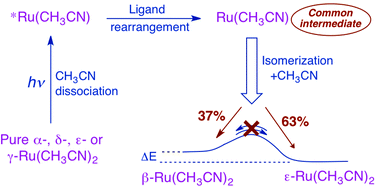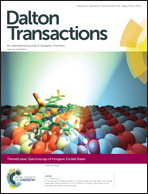Isomerization initiated by photoinduced ligand dissociation in Ru(ii) complexes with the ligand 2-p-tolylpyridinecarboxaldimine†
Abstract
The excited state reactivity of Ru(II) complexes continues to be a topic of intense investigation because of their widespread use in applications related to solar energy conversion, such as in photoswitches and for medicinal chemistry. In an effort to gain further understanding of photoinduced ligand exchange and isomerization in Ru(II) complexes, various isomers of the formula [Ru(PTPI)2(CH3CN)2]2+ (PTPI = 2-p-tolylpyridinecarboxaldimine) were synthesized and characterized, as well as the tris-heteroleptic complexes cis-[Ru(bpy)(PTPI)(CH3CN)2]2+ (1, bpy = 2,2′-bipyridine) and cis-[Ru(bpy)(PAP)(CH3CN)2]2+ (2, PAP = 2-(phenylazo)pyridine). All of the complexes containing the PTPI ligand undergo photoinduced ligand exchange of the CH3CN ligands with the coordinating solvent. Each isolated di-substituted PTPI complex, however, also undergoes isomerization of the bidentate PTPI ligands upon irradiation in CH3CN to produce the same ratio of a mixture of 63% ε-[Ru(bpy)(PTPI)(CH3CN)2]2+ and 37% β-[Ru(bpy)(PTPI)(CH3CN)2]2+. Experiments reveal that the isomerization of PTPI only occurs after the process of ligand dissociation is initiated by light. Evidence of isomerization following photoinduced ligand dissociation was also observed in 1, but not for the analogous complex 2. Electronic structure calculations, which included the relative overall energies of the isomers, and emission data were used to explain the results. The work presented herein may be useful in the design of new complexes for solar energy conversion or photoswitching applications.

- This article is part of the themed collection: Spectroscopy of Inorganic Excited States

 Please wait while we load your content...
Please wait while we load your content...